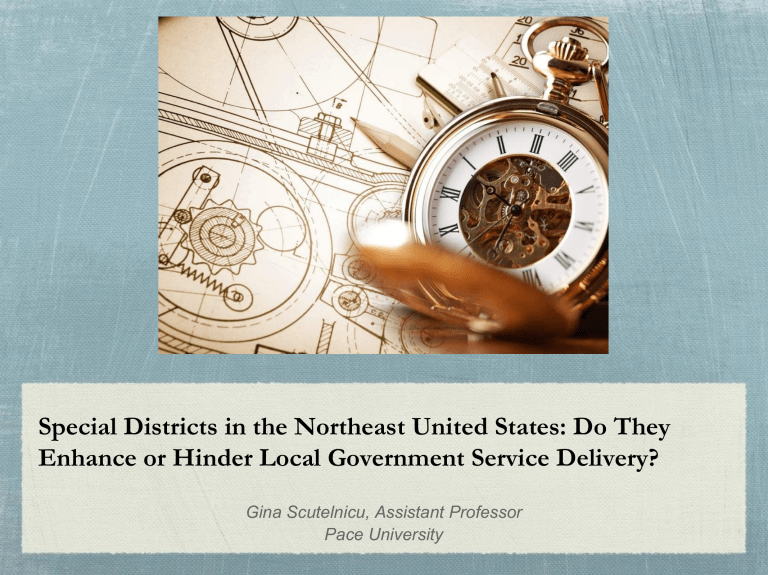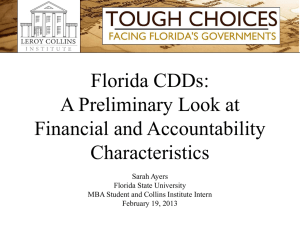Special Districts in the Northeast United States: Do

Special Districts in the Northeast United States: Do They
Enhance or Hinder Local Government Service Delivery?
Gina Scutelnicu, Assistant Professor
Pace University
Special Districts
•
Independent, special-purpose units of local government
•
Professionalize public services management
•
Single vs. multiple functions - 90%/10%
•
Enjoy limited general and special powers
•
Do not have planning and zoning powers
“The Shadow Governments”
•
Characteristics:
•
Narrow specialization
•
Administrative and financial independence
•
Geographic flexibility
•
Low political visibility
•
Status of SD
Dependent vs. independent https://www.census.gov//govs/go/sd.html
Theoretical and Empirical Evidence
Specialized vs. General-Purpose Governance
•
Metropolitan reform theory vs.
public choice theory.
• Consolidation vs. Fragmentation
• Do not differentiate special districts
Contribution:
•
How does service delivery occur at the local level?
•
Develop a typology of SD based on state level data
•
Assesses SD performance by function
•
Specialized governance less efficient than generalpurpose governance (Berry,
2009; Foster, 1997; Mullin,
2009;)
•
Economies of scale vs. economies of scope
(Hooghe & Marks, 2003)
•
Responsiveness, accountability and equity not rigorously investigated
•
Efficiency operationalization variation
Study Objectives
•
Develop a typology of multi-purpose special districts based on state data (NE states)
•
Special districts classification varies (Eger III, 2006;
Foster, 1997; Porter et al., 1992)
•
Consistent classification across state boundaries:
Activity
Creation method & oversight
Status
Structure
Multi-Purpose Special Districts
•
Focus on economic & community development
I. Economic development (BIDs) - 9 states
•
Manage and fund street improvements; parking; sanitation; security; landscaping; marketing & special events etc.
II. Community development (CDDs) - two states (PA & NY)
“Growth pays for itself”
Manage and fund new infrastructure improvements & maintenance; public utilities; recreation facilities and transportation-related services
MultiPurpose Special Districts Cont’d
•
SD centralized agency (NJ, NY & PA)
•
Reporting information about SD finances - a formality
•
Districts services are intended to supplement GP government services
•
BIDs focus on commercial/industrial only
•
CDDs focus on residential, commercial & mixed use
Districts Creation and Oversight
Creation process:
Petition method: petition of property/business owners public hearing ordinance or resolution of municipality
Referendum method
Public hearing method
Duration:
BIDs are time-limited or revised at certain intervals by municipalities
CDDs as perpetual entities
Annexation/incorporation issues
Managerial & FinancialAutonomy Cont’d
Dependent:
Appointed board of supervisors
Generate own revenues with approval of GP govts.; municipalities issue bonds
Under close supervision of municipalities
Limits are placed on taxes/assessments
Managerial & FinancialAutonomy
Independent:
E lected board of supervisors (all CDDs)
Generate own revenues - assessments, taxes, issue bonds
Once established, no clear oversight
Lack of coordination and cooperation between the general and the special-purpose governments
File reports and budgets for information only
Conclusion
•
Multi-purpose districts suitable for economic & community development functions
•
Great variety “hidden side of government”
•
Few states keep track of their SD & require reporting enforcement
•
Varying managerial & financial autonomy
Future Research
•
Assess Accountability to Performance
•
Assess multi-purpose districts nationally:
Efficiency; Responsiveness; Accountability and Equity









